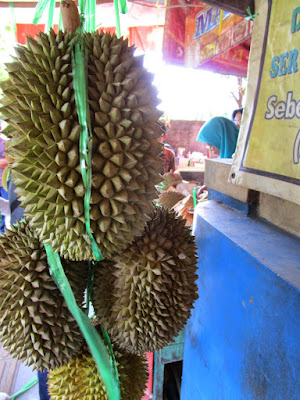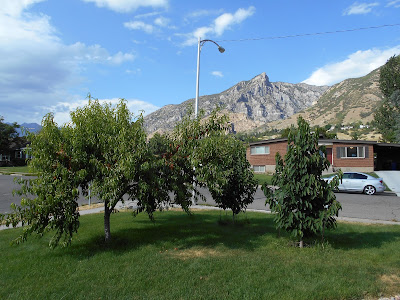"Most of us are still related to our native fields as the navigator to undiscovered islands in the sea. We can any afternoon discover a new fruit there which will surprise us by its beauty or sweetness....As I sail the unexplored sea of Concord, many a dell and swamp and wooded hill is my Ceram and Ambonya. Famous fruits imported from the East or South and sold in our markets--as oranges, lemons, pine-apples, and bananas--do not concern me so much as many an unnoticed wild berry whose beauty annually lends a new charm to some wild walk or which I have found to be palatable to an outdoor taste."
--Henry David Thoreau,
When he wrote these words during the nineteenth century, Thoreau was saying something similar to what his friend Ralph Waldo Emerson had said on the question of travel: "Traveling is a fool's paradise." Except Thoreau was saying that not only is travel a fool's paradise--it's also a fool's paradise to travel metaphorically by eating non-native fruits, originating from Indonesia or the Caribbean, while living in your hometown (whether your hometown is Concord, Massachusetts, like Thoreau's, or Provo, Utah, like mine).
I like the idea of Thoreau thinking of himself as sailing the seas of Concord, finding a feral apple tree or a cranberry bog and regarding them as his own personal Indonesian spice islands. His prize during these landlocked (but metaphorically seafaring) adventures was the "unnoticed wild berry." Of course, even as a seemingly benign woods-walker in Concord, Thoreau was walking on land that was taken from Native Americans. But still, I imagine indigenous populations all over the world would have been pleased if more people from Thoreau's larger tribe would have taken Thoreau's approach to colonialism: stay in your hometown and let your treasure be the unnoticed berry you find there.
This blog is about an unnoticed berry, the pawpaw (Asimina triloba), a native of my hometown. Or, it's not. Better, this blog is about a fruit that has been mostly unnoticed, a native of my home country, the United States, but actually only native to the eastern half of the United States. And because, like I say, my hometown these days is Provo, Utah, my hometown is outside the pawpaw's home range. If an expatriate is someone who lives in a foreign country, then, living outside of the home range, I'm an expatriate pawpaw watcher, and an expatriate pawpaw grower. And the pawpaws I grow are expatriate pawpaws.
I could make a pretense to being a follower of Thoreau. I'm living in the United States and growing a native American fruit, I could say. But none of this is really keeping Thoreau's advice. If I kept Thoreau's advice, I wouldn't be an expatriate pawpaw-watcher. I might instead sail the seas of the Wasatch Mountains, the western-most branch of the Rockies, gathering service berries and thimble berries. My family and I do that sometimes. But for me, even outside of the pawpaw's home range, and in the face of what Thoreau says about keeping company with fruit from our own hometowns, it's always the pawpaw.
In his newly published book Pawpaw: In Search of America's Forgotten Fruit, Andrew Moore points toward the pawpaw's tropical flavor: "For those who travel, dream of traveling, or have moved to the United States from tropical regions, the pawpaw is a way to make the world a bit smaller, to bring faraway places to a backyard in Ohio, Indiana, or Michigan." Yes, it is that. One of my neighbors, of Hawaiian descent, was over at our house a couple days ago and asked if our pawpaw trees were peach trees. I said they were pawpaw trees, native to the eastern half of the United States. I parted the long leaves and showed her one of the fruits. She said, "What does it taste like? A mango?" I answered, "Yeah kind of. How did you know?" (If you've found your way to this blog, I imagine you don't need to be reminded that the pawpaw's flavor is often compared to a mango's.) No doubt, there's something tropical about the pawpaw.
But if for some people the pawpaw helps them reminisce about fruits of tropical climes like Indonesia, the fruits of Indonesia have helped me reminisce about the American pawpaw. Emerson counseled against travel (that "fool's paradise"), but my family has recently undertaken just such a thing. We've just returned to Utah, in July, after spending six months in Indonesia, close to Thoreau's Indonesian islands of "Ceram and Ambonya." I was teaching about US history and culture at a university on the island of Java.
Really, this isn't about comparing the pawpaw to the fruits of Indonesia and saying that the pawpaw is better. It's more about saying that even when we were surrounded by such a riot of fruit, it was still somehow about the pawpaw.
In Indonesia, we were lucky to be in a place with fruit markets and street-side vendors almost on every corner.
We went to the market every other day and bought fruit, like the mangosteens in the foreground here, which have been one of my favorite fruits since I first tried them on an abandoned beach when I was thirteen.
We also bought a lot of dragon fruit, of the variety that's deep red inside, and which in Indonesia taste almost as good as they look.
We would have big feasts, strewing their skins and husks across the table. But when my kids would ask, "Okay now what's your favorite fruit," it was always the pawpaw.
While we were in Indonesia, one of our friends in Utah did us the favor of taking pictures of the fruit trees in our yard back home. He took a great picture of the Elberta peach tree's blossoms.
But I was more interested in his picture of the pawpaw blossoms, on our Wells cultivar, on 29 March.
Still, we were in Indonesia, among a riot of fruit, and sometimes that fruit did crazy things. One Saturday morning we found two bananas, fused together, among the cluster we had bought the day before. I had never seen a double banana before, and I've eaten a lot of bananas.
We took it as a good omen and later that day we wandered into a Taoist and Buddhist temple.
There were apples and oranges and bananas on the counters.
And among those bananas, another double banana. What? Two double bananas in one day? After a lifetime of never seeing one? A double omen. But still, it was about the pawpaws.
So I was glad when our friend sent more pictures, now in mid-April, of the pawpaws blooming.
Some people say the blossoms smell like rotten meat and others say they smell like wine or rising bread. I don't deny this. But over a decade ago, when my wife (NJ) and I smelled them for the first time, we thought they smelled like Nacho Cheese Doritos. But these were just pictures from a friend. We were thousands of miles away, and couldn't smell them, because we were in Indonesia.
Expatriates, far away from the pawpaws, we were at fruit markets with hanging clusters of rambutan.
And we visited durian vendors with friends who knew how to pick the best. As one of our hosts said, "They say the durian is the king of fruits. Well, our family is the king of durians!"
They were delicious. And in terms of their taste, there was something structurally similar to the pawpaw. Custard is a common metaphor for both the durian and the pawpaw. And then, as you're eating either fruit, along with the custard taste, you get the sense that a fly is waiting somewhere close, hoping to lay eggs and start a family in the custard.
After six months among the mangosteen, rambutan, durian, papaya, and bananas, we flew back into the Salt Lake Valley, where the international airport is next to the Great Salt Lake.
Here in the Great Basin, our rivers don't flow to the sea. They flow into the Great Salt Lake and make brine. In Utah, the soil is alkaline, far from the acidic soil of the eastern United States that the pawpaw likes.
But here our pawpaws are, on 20 July, growing in the alkaline soil at the edge of the Rocky Mountains. We planted them four years old, ordered from One Green World. On the left is our Elberta peach tree, in need of serious pruning since we were gone for six months. In the middle is our unimproved pawpaw tree, originally planted as the Sunflower cultivar, but the graft failed and the unpedigreed roots sent up a new stalk. And on the right is another pawpaw, the Wells cultivar, which I've just learned from Andrew Moore's book was once the winner of a contest sponsored by the pawpaw people at Kentucky State University.
And then across the driveway, on the left, is our third pawpaw tree, the KSU-Atwood cultivar. And on the right: one of Neal Peterson's pawpaws, the Shenandoah cultivar. We planted these two trees three years ago.
Still among rioting fruit even back in Utah, we were greeted by a peach tree with maybe two hundred peaches on it.
Our pawpaws are more mild mannered though. Only the Wells has fruit on it. But we're excited: this is the first year any of them has born fruit.
The Wells has four pawpaws on it.
And so here we are, standing at the edge of a new era for us. It's been seven years since we moved from Virginia to Utah. NJ and I haven't tasted a pawpaw since September 2007. Within a month or so, we'll be eating Utah pawpaws.























I am so happy to find someone succeeding at growing pawpaws in Utah! I've been considering it for a few years now, but wasn't sure they'd make it in our dry air, alkaline soil, and high altitude. I'm definitely going to do it now. Thank you!
ReplyDeleteSo glad to hear you're going to give it a try! Let me know how it goes. Do you have your eyes on any cultivars in particular?
DeleteDo you grow your paw paw varieties in Payson? we live in Stansbury Park. I have been considering sunflower, mango, NC-1...
ReplyDeleteHow did you come to the conclusion to get the varieties that you did. I am having a hard time deciding.
The best guide that I know of on the different varieties is in the back of Andrew Moore's book, "Pawpaw: In Search of America's Forgotten Fruit." Moore has descriptions of dozens of cultivars with statements on the flavor and texture given by people he met while researching his book. Generally, I'd say the Peterson varieties of pawpaw are the gold standard for "improved" cultivars, in terms of size and flavor and quantity. The KSU-Atwood is also a prolific bearer and tastes good.
ReplyDelete